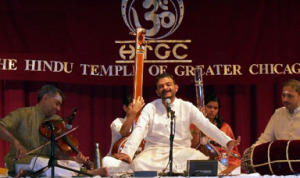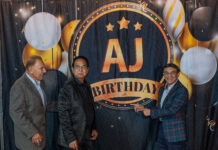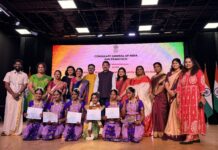 CHICAGO: Hindu Temple of Greater Chicago (HTGC) Fine Arts Committee in conjunction with R.R. International and Raja Veena School of Music hosted Carnatic vocalist T.M. Krishna in a concert on October 10 in Lemont, a southwest suburb of Chicago. Accompanists R.K. Sriram Kumar and Arun Prakash responded to Krishna’s brilliant musical ideas with equal expertise on violin and mridangam.
CHICAGO: Hindu Temple of Greater Chicago (HTGC) Fine Arts Committee in conjunction with R.R. International and Raja Veena School of Music hosted Carnatic vocalist T.M. Krishna in a concert on October 10 in Lemont, a southwest suburb of Chicago. Accompanists R.K. Sriram Kumar and Arun Prakash responded to Krishna’s brilliant musical ideas with equal expertise on violin and mridangam.
Krishna began with a rare musical piece “Sri Guruna Palitosmi” by Muttuswamy Dikshitar in ragam Padi set to Rupaka talam in relaxed tempo, developing the composition through neraval, that is, by elaborating on the notes for a particular line within the rhythmic framework to bring out the emotional flavor of the ragam and through extempore musical notes (kalpana svara).
This was followed by Tyagaraja’s composition “Vandanamu Raghunandana” in ragam Sahana, set to Adi tala. Its soul stirring lyrics were meticulously brought out through his powerful yet soothing voice during the neraval on the phrase “vegara karunakara.”
Krishna then developed ragam Varali in all its intricacy, emphasizing its distinctive life-giving notes (jiva svara). It was as if vocalist and violinist were pursuing a musical conversation reading each other’s minds, their innovative musical phrases creating a beautiful, serene and calm environment.
He continued with a very brisk rendering of tanam, exploring the ragam in a faster rhythmic tempo using mnemonic syllables (ta nom ta and ananta) and transporting the audience. Tyagaraja’s “Inta Soukhya” in Adi talam was preceded by detailed multifaceted exploration (alapanam) of its ragam Kapi covering all three octaves. Lyrics of compositions in slow tempo are held over a long duration and thus demand great musical artistry and breath-control to be sung with ease and aesthetic appeal. Krishna’s rendering was superb and melodious. Prakash’s intricate rhythms and Ramkumar’s embellishments made it a much applauded masterpiece. Neraval and Kalpana svaras that followed were breathtaking.
Shyamashastri’s popular composition “Marivere” in ragam Anandabhairavi set to Misrachapu talam then described the wonderful qualities of the goddess Kamakshi.
The pallavi in Tamil “Tadhimita dhim Kanaka Sabheyil Ananda Natanam Adinar” describing Lord Shiva dancing in the golden hall of Chidambaram temple, was in the majestic Kambhoji ragam. This was an Atita Pallavi, meaning the song starts even before the set rhythm, Tisra Adi in this case. Krishna’s creative imagination excelled in rendering the pallavi also in Kalyani, Bhairavi, Nata, Begada, Hamir Kalyani and Sindhubhiravi, thus making a wonderful garland of ragas.
Krishna concluded with devotional songs in various languages. He rendered Purandara Dasa’s old time but very popular Kannada “Kelano Hari Talano” in Kalyani ragam and then a Tamil devotional, leading into Muttuswamy Dikshitar’s “Sri Dakshina Murte’ in ragam Shankarabharanam, before the auspicious mangalam.
Dr Jaishree Prasad






